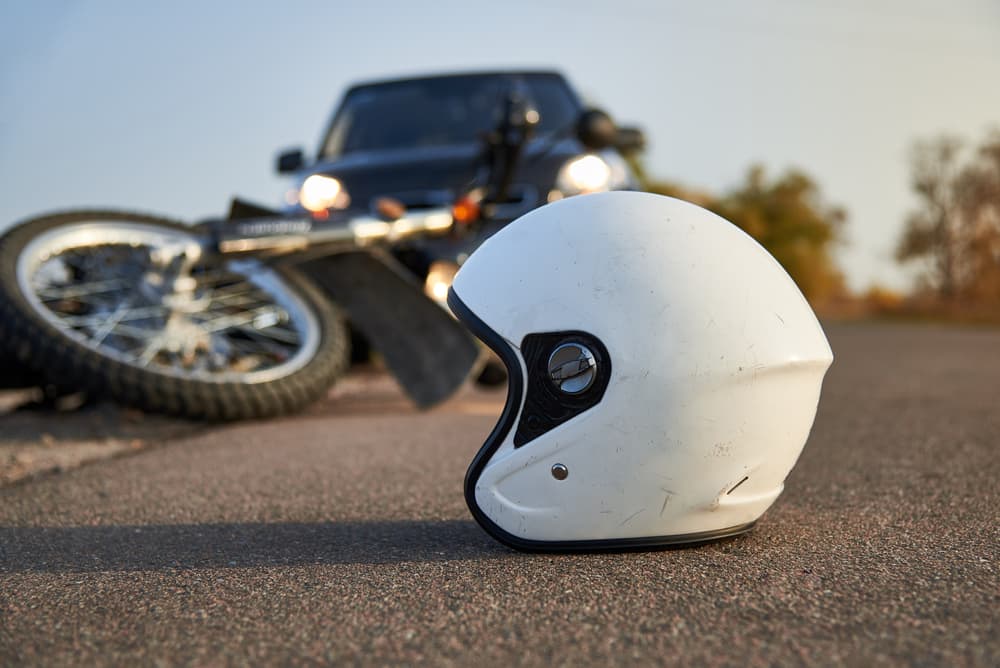Motorcycle accidents frequently cause head injuries, road rash, broken bones, and spinal cord damage. These most common types of severe motorcycle accident injuries result from the rider’s direct exposure to the force of a collision with a larger vehicle or the road surface itself.
When another driver's negligence causes these harms, you have the right to seek fair compensation for your medical care, lost income, and the profound impact on your life. Figuring out what to do after you suffer harm can feel confusing, but you don't have to manage it alone.

Key Takeaways for Common Types of Motorcycle Accident Injuries
- Head and brain injuries represent some of the most catastrophic outcomes, even when a rider wears a helmet.
- Lower-extremity injuries to the legs, feet, and pelvis are extremely frequent, often resulting in complex fractures.
- Road rash is a common injury that ranges from minor abrasions to severe wounds requiring skin grafts and causing permanent scarring.
- Internal injuries, such as organ damage or internal bleeding, present a hidden danger and require immediate and thorough medical evaluation.
- The long-term effects of motorcycle injuries often include chronic pain, psychological trauma, and significant financial strain from ongoing care.
Traumatic Head and Brain Injuries
The force of a motorcycle crash can cause devastating harm to a rider's head and brain. Even with a helmet, the impact can jolt the brain inside the skull, leading to a traumatic brain injury (TBI). These injuries vary widely in their initial presentation and long-term consequences.
A TBI can disrupt normal brain function, affecting everything from your memory and concentration to your emotional regulation. Many riders who experience a TBI face lasting challenges that interfere with their ability to work, maintain relationships, and perform daily tasks.
The recovery process is often lengthy and requires extensive rehabilitation.
Concussions and Skull Fractures
A concussion is a type of mild TBI that occurs from a blow to the head. Symptoms include headaches, dizziness, confusion, and memory issues. While many concussions resolve with rest, some can have lingering effects that last for months.
A more direct and violent impact can cause a skull fracture, which is a break in the cranial bone. These fractures can lead to dangerous complications like brain swelling, bleeding, or infections.
Prompt surgical intervention is often necessary to address the damage and relieve pressure on the brain.
Long-Term Cognitive and Emotional Effects
The true toll of a brain injury often reveals itself over time. Beyond the initial physical trauma, many survivors grapple with persistent cognitive deficits, such as difficulty with problem-solving and communication.
The emotional and behavioral changes can also be profound, with many people experiencing mood swings, irritability, anxiety, and depression. These changes affect not only the injured rider but their entire family.
Road Rash
When a motorcyclist is thrown from their bike, their body often slides across the abrasive pavement at high speed. This violent contact rips away layers of skin, causing a painful and potentially disfiguring injury known as road rash.
While sometimes dismissed as mere scrapes, severe road rash can cause extensive damage to skin, tissue, and nerves. The severity of road rash dictates the necessary medical treatment, as serious abrasions create a high risk of long-term problems.
Beyond the initial pain, serious complications can develop, such as:
- Serious Infections: Open wounds can easily become infected with bacteria from the road surface, which may lead to dangerous conditions like cellulitis or sepsis without aggressive medical intervention.
- Permanent Scarring: Deeper abrasions that damage the lower layers of skin often result in significant and permanent scarring, which can serve as a lifelong reminder of the trauma.
- Nerve Damage: Abrasions that scrape away skin and underlying tissue can damage superficial nerves, leading to chronic pain, numbness, or a permanent loss of sensation in the affected area.
Proper riding gear, such as leather or reinforced textiles, provides a critical layer of protection that can reduce the severity of road rash. Even with protective clothing, however, the immense friction and force involved in a slide can still cause significant skin injuries.
Complex Bone Fractures and Joint Damage
Broken bones are among the most frequent and debilitating types of severe motorcycle accident injuries. A rider's body has no structural protection, and the force of an impact with another vehicle or the ground often results in fractures to the arms, legs, pelvis, and ribs.
These aren’t always simple breaks; many are complex fractures that require extensive medical intervention.
Some common examples of fractures include:
- Lower-Extremity Injuries: The legs and feet are particularly vulnerable. Fractures to the femur (thigh bone), tibia (shin bone), and fibula are common and often require surgery to implant rods, plates, or screws for stabilization.
- Arm and Wrist Fractures: It’s a natural instinct to throw your arms out to break a fall or cover your face. This reflex frequently leads to broken wrists, forearms, and elbows as the rider hits the pavement.
- Pelvic Fractures: A fracture of the pelvis can cause life-threatening internal bleeding and damage to nearby organs. Recovery is typically long and requires significant limitations on mobility.
- Rib Fractures: Impact to the chest area can easily break ribs. These injuries are very painful and carry the risk of puncturing a lung or other internal organs.
Recovery from these types of fractures often involves a long and arduous process. It can include one or more surgeries followed by months of physical therapy to restore strength and range of motion.
Spinal Cord and Nerve Damage
A forceful impact in a motorcycle crash can twist or compress the spinal column, leading to catastrophic spinal cord injuries. Damage to the spinal cord can disrupt motor control, sensation, and other bodily functions below the site of the injury.
The consequences of spinal cord damage are often permanent and life-altering. An injury to the lower back might result in paraplegia, which is paralysis of the legs and lower body.
Damage higher up the spinal column, in the neck region, can cause quadriplegia, which affects both the arms and the legs. Living with paralysis requires a lifetime of medical care, assistive devices, and home modifications.
Biker’s Arm and Nerve Paralysis
A specific type of nerve damage common in these accidents is sometimes called "Biker's Arm." This happens when the motorcycle falls on the rider, crushing an arm and damaging the complex network of nerves that run from the shoulder to the hand.
This nerve damage can lead to chronic pain, loss of sensation, or even permanent paralysis of the arm, impacting a person's ability to work and perform simple daily tasks.
The Hidden Impact of Nerve Damage
Nerve damage isn't always as dramatic as paralysis. Soft tissue injuries from a crash can also stretch or tear nerves, leading to chronic pain conditions, numbness, or tingling sensations in the limbs.
These symptoms can be just as debilitating, making it difficult to hold objects, walk, or even sleep comfortably.
5 Steps To Take After a Motorcycle Accident
Once you have received medical treatment, certain actions can help you protect your rights and prepare for a potential injury claim.
These steps are designed to support that process from a legal and financial standpoint:
- Organize Your Documents: Create a file to store all accident-related paperwork in one location. This includes the police report, the other driver's information, medical records from the hospital and your doctors, and receipts for any expenses you've incurred.
- Document Your Injuries and Recovery: Keep a simple journal to track your progress. Note your pain levels each day, any difficulties you have with daily activities, and how your injuries are affecting your life and sleep. Taking photos of your visible injuries as they heal can also provide useful visual evidence.
- Track All Your Expenses: Log every cost associated with the accident, including medical bills, prescription co-pays, mileage for travel to and from doctor appointments, and any home modifications you need.
- Record Your Lost Wages: Keep careful records of the time you have missed from work. Obtain a letter from your employer confirming your pay rate and the exact dates you were unable to work due to your injuries.
- Contact an Experienced Attorney: An attorney helps you manage the complexities of an injury claim. They can handle communications with insurance companies, gather evidence to establish the other party's fault, and work to secure the compensation you need.
The Long-Term Consequences Riders Face
The effects of a serious motorcycle crash extend far beyond the initial hospital stay. Many riders face a future marked by physical, emotional, and financial challenges.
When considering the most common types of motorcycle accident injuries, it’s necessary to evaluate the lasting impacts that change a person's life forever.
The journey toward recovery can involve many hardships:
- Chronic Pain: Many injuries, particularly those involving nerve damage or complex fractures, result in chronic pain that persists for years. This ongoing pain can limit a person's ability to work, sleep, and enjoy life's activities.
- Emotional Trauma: Surviving a traumatic event like a motorcycle accident often leaves deep emotional scars. Many riders develop post-traumatic stress disorder (PTSD), anxiety, or depression. Flashbacks, nightmares, and a fear of riding again are common psychological impacts.
- Financial Instability: The combination of extensive medical bills and an inability to work can quickly lead to financial distress. Future medical needs, like additional surgeries or long-term therapy, add another layer of financial uncertainty.
- Loss of Independence: Severe motorcycle accident injuries can leave a rider with permanent disabilities. A person might lose their ability to live independently, requiring ongoing help from caregivers or significant modifications to their home and vehicle.
How a Motorcycle Accident Lawyer Helps Your Personal Injury Claim
An attorney provides critical support as you pursue the financial resources needed for your recovery. They take on the legal burdens so you can focus on your health.
Specific ways an attorney assists you include:
- Collecting Evidence: A lawyer thoroughly investigates the accident to gather all available evidence. This includes obtaining the police report, interviewing witnesses, and hunting down traffic footage.
- Calculating Damages: Your attorney may work with medical and financial professionals to calculate the full value of your claim. This calculation encompasses all current and future medical expenses, lost income, reduced earning capacity, and non-economic damages, including pain and suffering.
- Communicating With the Insurance Company: Your personal injury lawyer handles all negotiations with the at-fault party's insurance company. Insurers often try to minimize payouts, but an attorney advocates for a fair settlement that reflects the true cost of your injuries.
- Legal Process Management: If the insurance company refuses to offer a fair settlement, your motorcycle accident lawyer prepares and files a personal injury lawsuit on your behalf. They manage all legal deadlines and procedures required to move your case forward.

FAQ for What Are the Most Common Types of Motorcycle Accident Injuries
What Type of Injury Is Most Common in a Motorcycle Accident?
Lower-extremity injuries to the legs and feet are the most common non-fatal injuries in a motorcycle accident. Road rash, broken bones, and spinal cord injuries are also very frequent. However, head injuries are the leading cause of death in motorcycle crashes.
How Can I Claim Compensation for My Injuries?
To claim compensation, you typically file a claim with the at-fault driver's insurance company. You must provide evidence that the other driver was negligent and that their negligence caused your accident and injuries.
An attorney can manage this entire process for you, from collecting evidence and documenting your losses to negotiating a fair settlement.
What Compensation Can I Recover in a Motorcycle Injury Claim?
You can recover compensation for a wide range of losses, which the law refers to as damages.
This compensation may cover:
- Economic Damages: This includes all your medical bills (past and future), lost wages from missing work, and your diminished ability to earn income in the future.
- Non-Economic Damages: This category of compensation addresses your intangible losses, such as your physical pain, emotional distress, scarring or disfigurement, and loss of enjoyment of life.
- Exemplary Damages: These damages punish the defendant for their gross negligence and deter similar conduct in the future, rather than to compensate the plaintiff for their losses.
Does Failing To Wear a Helmet Affect My Injury Claim?
In Texas, riders over the age of 21 aren’t required to wear a helmet if they meet certain health insurance requirements or passed specific safety courses. However, insurance companies may try to argue that your failure to wear a helmet contributed to the severity of your head injury.
This tactic attempts to reduce the value of your claim, but an experienced attorney can counter these arguments to protect your compensation.
How Do Insurers Determine Fault for Common Injuries From Motorcycle Crashes?
Insurers determine fault by reviewing all available evidence from the accident. They analyze the official police report, which may contain an officer's initial assessment of what happened.
Insurance adjusters also review witness statements, photos of the accident scene and vehicle damage, and sometimes traffic camera footage to piece together the sequence of events and assign liability.
Seek Compensation With Lorenz & Lorenz, PLLC
The moments after a motorcycle accident can feel chaotic, but your path forward doesn’t have to be. Your energy is best spent on your physical and emotional recovery—on rebuilding your life. Let a dedicated legal advocate handle the fight for the financial resources you need.
Contact Lorenz & Lorenz, PLLC today at (512) 477-7333 for a free consultation to discuss your case and discover how we can assist you.
